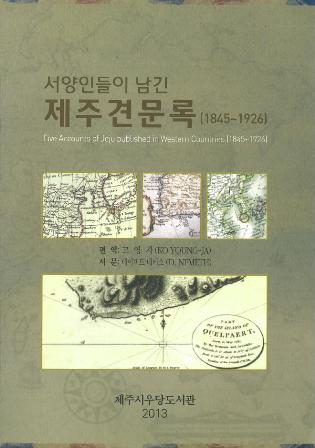|
| |
 |
|
| ▲ The scenes encountered in China on the same trip that brought Belcher to Jeju. Taken from Edward Belcher (1843). Narrative of a Voyage Round the World. Volume 2 |
“Five Accounts of Jeju Published in Western Countries [1845-1926]” was published in 2013 and is a collection of texts covering Jeju’s early encounters with Westerners. Korean translations accompany the original English texts and David Nemeth, longtime Korea enthusiast and academic, wrote the preface.
Recalling the Korean proverb, “The light is darkest under the lamp,” Nemeth, who laments his own work on the subject has appeared in “seldom-read academic venues,” praises the volume for slaking the thirst of islanders wanting to know more about early European and American contact. The book, he says, sheds light on the “uninvited, intrusive outsiders as they observe ... what they perceive to be an isolated, exotic island.”
The volume was edited and translated by Dr. Ko Young-Ja, Jeju City Chief Librarian, and she concedes that some of the accounts’ haughty tone toward Jeju has not been welcomed by all, but she stresses their significant historical worth.
“This point of view was even common on the mainland in those days — Jeju was considered a backwards island, for horses not people,” she said, adding there is immense interest in the descriptions of the “everyday life of the people and landscape.”
A motley crew of travelers
The five accounts include the work of Edward Belcher (1845), Charles Chaille Long (1888), A.A. Pieters (1898), M.P. Anderson (1913), and Robert Burnett Hall (1926). With the English originals also provided, the book’s beauty is in its ability to provide a window not just on Jeju, but on the mindset of the age. The west’s “impertinent curiosity,” writes Nemeth, was often just one expression of an “arrogant and pompous” orientalist attitude which defined the Age of Empire.
For the anthropologist, the earlier accounts from Belcher, Long and Pieters are likely to be of most interest. Anderson, as is a scientist’s wont, is more concerned with documenting the flora and elusive fauna than the people, all the while avoiding his nemesis, the inclement weather. Hall, unlike the others, never visited the island, and his work accordingly lacks warmth, reading like an encyclopedic entry.
Belcher’s contribution is a log of his capers as a British naval officer on H.M.S. Samarang in 1845, and it provides both mirth and consternation as he lands at Udo and spends a number of days surveying the local geography. Belcher reminds of the accounts of Arnold Henry Savage Landor, but with less of the eccentric painter’s charm, and more of the unabashed racism of the age. Belcher writes of the locals:
“[They] were so filthy in their manners and persons, that it became a matter of necessity to keep them aloof. [They were] so far beyond the bounds of decorum, that they were very soon taught that the white-faced foreigner was able to punish their presumption, even without the assistance of weapons.”
Long has more empathy for the Jeju people, making for a more evocative tone. The scene, as Long is received in “Pelto,” a settlement on the north coast, is described thus:.
“The houses are built of black rock, with thatched roofs. Surrounded by a wall of the same material, the town has an air of solidity which gives it the appearance of having been a fortified place. In fact, it is out of this very port, doubtless, that the Mongols sailed with their fleets to prey upon the commerce of that day.”
Long, whose imagination is refreshing alongside the other accounts, even wonders, upon seeing local cavalry, whether he was setting eyes on “a ghostly apparition of what seemed a detachment from the armies of Genghis and Kublai Khan.”
Pieters is more scientific in his documentation of the flora, fauna and livestock, but there are memorable entries. His admiration of Jeju women’s work ethic is matched by his observation of male slovenliness: “As almost everything is done by the women, there remains nothing else for the men to do but loaf, and to do them credit they do it well.”
Pieters interests are broad and he provides glorious descriptions of Mt. Sanbangsan, Jeju’s snake worship, and even a fascinating window on local clothing, housing, economy, geography and religion, traces of which are recognizable even today.
The collection as a whole is a joy to read and is very much reflective of Westerners’ periodic travels in the East. Familiar echoes are found of A.H. Savage Landor, as mentioned, and also Frederick Arthur MacKenzie and his travels in late-Joseon and colonial Korea.
The accounts are fascinating windows not only on Jeju society, but on world history, too. The five stories of derring-do transport us to an age of adventure and empire, and the reader is confronted with worldviews which, while often distasteful, continue to shape contemporary geopolitics in some form.
One weakness of the volume is the omission of historical and biographical details about our protagonists, although this is available in the accompanying Korean text. Nemeth recognizes this oversight, but also believes that “too many cooks spoil the broth,” and it is already “a delicious reading experience.”
If one is left hungry for more on Belcher’s intent on Jeju’s shores, however, or for more about what fired Long’s zestful mind, plenty of resources are available online.
Later this year a second volume of translations of seven further accounts will be available for the Jeju public. In the meantime, the present volume can be found at Jeju’s public libraries. |





















